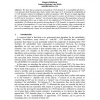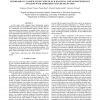2107 search results - page 52 / 422 » Computing Small Search Numbers in Linear Time |
CORR
2010
Springer
13 years 9 months ago
2010
Springer
A general framework for solving image inverse problems is introduced in this paper. The approach is based on Gaussian mixture models, estimated via a computationally efficient MAP...
AAAI
2006
13 years 10 months ago
2006
Voting (or rank aggregation) is a general method for aggregating the preferences of multiple agents. One important voting rule is the Slater rule. It selects a ranking of the alte...
CADE
2002
Springer
14 years 9 months ago
2002
Springer
We show that a conjunctive normal form (CNF) formula F is unsatisfiable iff there is a set of points of the Boolean space that is stable with respect to F. So testing the satisfiab...
STOC
2006
ACM
14 years 9 months ago
2006
ACM
We present the first randomized polynomial-time simplex algorithm for linear programming. Like the other known polynomial-time algorithms for linear programming, its running time ...
ICASSP
2009
IEEE
14 years 3 months ago
2009
IEEE
In this paper, block diagonal linear discriminant analysis (BDLDA) is improved and applied to gene expression data. BDLDA is a classification tool with embedded feature selection...


